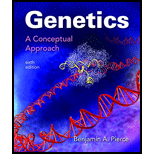
a.
To determine:
The characteristics that a person would expect to see in the DNA isolated from a strain with a temperature-sensitive mutation in the gene that encodes protein, DNA ligase.
Introduction:
Conditional mutations:
This mutationexpresses “mutant
E. coli strain is isolated, and it contains temperature-sensitive mutations in its genes that encode different components for the replication process. The protein produced in each of the strain is contained mutated gene that is nonfunctional under the “restrictive conditions”. They are grown under “permissive conditions” and further rapidly enter to the “restrictive condition”. Under the restrictive condition, after one round of
b.
To determine:
The characteristics that a person would expect to see in the DNA isolated from a strain with a temperature-sensitive mutation in the gene that encodes. DNA polymerase I.
c.
To determine:
The characteristics that a person would expect to see in the DNA isolated from a strain with a temperature-sensitive mutation in the gene that encodes DNA polymerase III.
Introduction:
Conditional mutations:
This mutationexpresses “mutant phenotype” only in certain conditions called “restrictive conditions”, and “normal phenotype” in other conditions called the “permissive conditions”. Example of conditional mutation: a temperature-sensitive mutation that expresses the “mutant phenotype” only at certain temperatures.
E. coli strain is isolated, and it contains temperature-sensitive mutations in its genes that encode different components for the replication process. The protein produced in each of the strain is contained mutated gene that is nonfunctional under the “restrictive conditions”. They are grown under “permissive conditions” and further rapidly enter to the “restrictive condition”. Under the restrictive condition, after one round of DNA replication, from each strain, the DNA is isolated.
d.
To determine:
The characteristics that a person would expect to see in the DNA isolated from a strain with a temperature-sensitive mutation in the gene that encodes primase.
Introduction:
Conditional mutations:
This mutationexpresses “mutant phenotype” only in certain conditions called “restrictive conditions”, and “normal phenotype” in other conditions called the “permissive conditions”. Example of conditional mutation: a temperature-sensitive mutation that expresses the “mutant phenotype” only at certain temperatures.
E. coli strain is isolated, and it contains temperature-sensitive mutations in its genes that encode different components for the replication process. The protein produced in each of the strain is contained mutated gene that is nonfunctional under the “restrictive conditions”. They are grown under “permissive conditions” and further rapidly enter to the “restrictive condition”. Under the restrictive condition, after one round of DNA replication, from each strain, the DNA is isolated.
e.
To determine:
The characteristics that a person would expect to see in the DNA isolated from a strain with a temperature-sensitive mutation in the gene that encodes initiator protein.
Introduction:
Conditional mutations:
This mutationexpresses “mutant phenotype” only in certain conditions called “restrictive conditions”, and “normal phenotype” in other conditions called the “permissive conditions”. Example of conditional mutation: a temperature-sensitive mutation that expresses the “mutant phenotype” only at certain temperatures.
E. coli strain is isolated, and it contains temperature-sensitive mutations in its genes that encode different components for the replication process. The protein produced in each of the strain is contained mutated gene that is nonfunctional under the “restrictive conditions”. They are grown under “permissive conditions” and further rapidly enter to the “restrictive condition”. Under the restrictive condition, after one round of DNA replication, from each strain, the DNA is isolated.
Want to see the full answer?
Check out a sample textbook solution
Chapter 12 Solutions
Genetics: A Conceptual Approach
 Human Anatomy & Physiology (11th Edition)BiologyISBN:9780134580999Author:Elaine N. Marieb, Katja N. HoehnPublisher:PEARSON
Human Anatomy & Physiology (11th Edition)BiologyISBN:9780134580999Author:Elaine N. Marieb, Katja N. HoehnPublisher:PEARSON Biology 2eBiologyISBN:9781947172517Author:Matthew Douglas, Jung Choi, Mary Ann ClarkPublisher:OpenStax
Biology 2eBiologyISBN:9781947172517Author:Matthew Douglas, Jung Choi, Mary Ann ClarkPublisher:OpenStax Anatomy & PhysiologyBiologyISBN:9781259398629Author:McKinley, Michael P., O'loughlin, Valerie Dean, Bidle, Theresa StouterPublisher:Mcgraw Hill Education,
Anatomy & PhysiologyBiologyISBN:9781259398629Author:McKinley, Michael P., O'loughlin, Valerie Dean, Bidle, Theresa StouterPublisher:Mcgraw Hill Education, Molecular Biology of the Cell (Sixth Edition)BiologyISBN:9780815344322Author:Bruce Alberts, Alexander D. Johnson, Julian Lewis, David Morgan, Martin Raff, Keith Roberts, Peter WalterPublisher:W. W. Norton & Company
Molecular Biology of the Cell (Sixth Edition)BiologyISBN:9780815344322Author:Bruce Alberts, Alexander D. Johnson, Julian Lewis, David Morgan, Martin Raff, Keith Roberts, Peter WalterPublisher:W. W. Norton & Company Laboratory Manual For Human Anatomy & PhysiologyBiologyISBN:9781260159363Author:Martin, Terry R., Prentice-craver, CynthiaPublisher:McGraw-Hill Publishing Co.
Laboratory Manual For Human Anatomy & PhysiologyBiologyISBN:9781260159363Author:Martin, Terry R., Prentice-craver, CynthiaPublisher:McGraw-Hill Publishing Co. Inquiry Into Life (16th Edition)BiologyISBN:9781260231700Author:Sylvia S. Mader, Michael WindelspechtPublisher:McGraw Hill Education
Inquiry Into Life (16th Edition)BiologyISBN:9781260231700Author:Sylvia S. Mader, Michael WindelspechtPublisher:McGraw Hill Education





